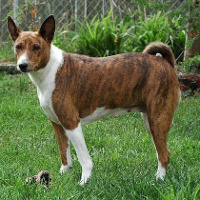Appearance of the Telomian
|
| The Telomian has a smooth, short coat. It has a blue or black tongue, similar to the Chow Chow. Its most common colors are tan and white, black and white or any form of sable and white. It can have a black mask on its face. Most people seem to prefer Telomians, which have less white and more color. They are small to medium-sized and very athletic. They measure 38 to 48 cm at the withers, weighing 8 to 13 kg. Because the Telomian is such a rare breed, there has been no real breed standard developed. There aren't enough dogs in this breed to define a true type and, as a result, their general appearance can vary. It should resemble a Basenji in head shape and alertness, but that's where the similarities should end, the Telomian being a distinctly separate breed. |
Temperament of the Telomian
|
| The Telomian is an extremely intelligent dog. It has plenty of prey and loves to run. Games that require his intelligence and prowess are particularly fun for him. He also likes interactive games or toys that make him think. It's best to remember that the Telomian isn't as domesticated as most dogs, so he needs intensive training and socialization from an early age. He is not recommended for families with small children, but can cope with older children who respect him and can exercise authority over him properly. The Telomian produces a very distinctive sound instead of a bark. It will emit a howl similar to that of the Basenji or the New Guinea singing dog. This doesn't mean he can't learn to bark if he grows up with other barking dogs. If he's a single dog, he won't learn to bark in the usual way. |
Needs and activities of the Telomian
|
| The difficult and complicated terrain of the jungle they inhabited makes them highly versatile and easily adaptable to a variety of environments. Keeping in mind their energetic and active nature, Telomians require a high level of activity. If they live in an apartment, at least two walks a day will suffice for this breed. If you have a secure or fenced yard, allow them to run around freely or even take part in chase games such as ball retrieving, catching, etc., which these dogs greatly appreciate because of the prey drive instincts present in them. Indoors, engage them with a variety of interactive toys to provide appropriate mental stimulation. Lack of adequate exercise and activity would force this breed to resort to destructive means of entertainment. Their quick wit, obedient nature and eagerness to please make training easier. Socialization training is of the utmost importance for Telomians from the moment they are puppies, so that they can adapt well to humanity. Expose them to new situations, organize appointments at a dog park, you can even enjoy the idea of sharing puppies at home, where your acquaintances' pets would also be present, helping your Telomian to mingle with other dogs. Keeping their hunting instinct in mind, you need to train your dog before taking him out. As soon as this dog likes to play, combine leash training with his play schedule. Play a ball, fetch the game with him after attaching the leash and once he's comfortable with it, pick up the leash and invoke your Telomian pet towards you in a gentle manner. Reward him with treats and praise afterwards. Since they can use their paws brilliantly and are even great climbers, teaching them tricks would be a walk in the park. Teach them how to do a salute by sticking a small piece of tape over their eyes and while your dog lifts his paw to remove it, shower him with praise and treats. |
Maintenance of the Telomian
|
| The Telomian is a low-maintenance dog. He should be brushed once a week with a natural bristle brush to remove loose or dead hairs and keep his coat shiny and clean. Generally, he only needs bathing when he develops an odor or gets dirty. Don't bathe him too much, and don't use strong shampoos, as these can strip the oils from his skin. When the oils are removed, he may develop dry, irritated skin. Use a mild shampoo when he needs a bath. Since he was bred in the Malaysian jungle, he's most comfortable when his habitat has a similar climate, usually between 21 and 32 degrees Celcius. He's an adaptable breed and can thrive in cold climates as long as his family offers sufficient protection from the elements. Trim his nails as needed, usually every two or three weeks. Check his ears once a week and clean them if necessary. Also establish a dental care regime that includes routine brushing and deep cleaning to ensure his gums and teeth are healthy. |







 English (United Kingdom)
English (United Kingdom)